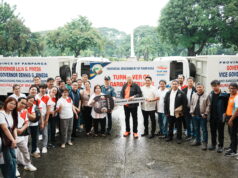1949. NO one remembers the exact date but it was at the now-extinct San Fernando Restaurant in the capital town that the Pampanga Press Club was founded.
There are also a number of variants on the mediamen who actually formed the PPC. Eight names though are constant: Silvestre Songco, Romeo Arceo, Emerito de Jesus, Alejandrino Songco, Lino Sanchez, Sr., Tomas San Pedro, Gregorio Sangil and Armando P. Baluyut.
The first “official headquarters” of the PPC was Camp Olivas, as it was the primary beat in the province. It being the headquarters of the First Military Area comprising all the provinces north of Manila and covering all major services of the Armed Forces of the Philippines.
The PPC sited in Olivas provided more than an historical footnote to the transformation of the military geography of north and central Luzon, from 1st Military Area to 1st Philippine Constabulary Zone to 3rd Regional PC-INP Command to 3rd Philippine National Police Command to its current 3rd PNP Regional Office. With the boys going through a practical who’s who among the military top brass, from Army Gen. Alfonso Arellano, through the likes of Ileto, Tanabe, Zerrudo onto Diaz, Gatan, Eduardo, Felix, through De Guzman, mateo, Ocampo, Taduran, up to Nazareno, Ventura, Aglipay and now, Calinisan.
The Eight Fathers
At Olivas, Beting Songco of Manila Times-Mirror-Taliba was the primus inter pares. Beting institutionalized journalistic “SS” with his ever present “three of the fatalities have remained unidentified as of press time” on top of the identified casualties in every report of a Huk-PC encounter.
For all his sensationalized style in reporting, Beting had this aversion to the tabloids of the time, notably News Behind the News. This was most manifest with a horrified Beting spitting out “Bastos!” at a picture – taken with a telephoto lens – of an American girl peeing on a rice paddy along a highway, captioned “American girl watering Philippine soil.”
There is not much of Romy Arceo that I came to know of than that he was editor of The Quezonian in his college years at the then Manuel L. Quezon Educational Institution, now MLQY. He came into local journalism with his brother-in-law Emerito de Jesus.
‘Marito of The Evening News covered the defense beat and soared to the post of Undersecretary for Munitions during the Macapagal administration. It was in his incumbency as PPC president – in 1958-1959 – that the club building at the Capitol compound was completed. Gov. Rafael lazatin leased the land to the PPC for 50 years. Pampanga PC Command chief Col. Leonardo Sangalang, Sto. Tomas businessman D.P. Canlas,owner of Manila Pencil Co., and Quirino D. Yap of San Fernando’s QDY Lumber & Hardware and Café Fernandino were the principal benefactors.
Toto Songco started the construction of the PPC building while president in 1957. He was already out of the Philippine News Service and was head of the National Media Production Center for Central Luzon when I met him in 1975. He wanted me to transfer to his office from the department of Public Information.
Lino Sanchez, Sr. of The Manila Times, most unfortunately for me, I did not meet. The stories about him that stuck in my mind were his penchant for scoops. In the midst of coverage and even mundane conversations, he regularly disappeared for no apparent reason. His peers would just read in the next day’s Times stories they did not know about. Lino made a contribution to the local lexicon of those times with his “Huklings” in reference to young Huk partisans.
It was Don Tomas San Pedro that opened the pages of his Pampanga Newsweek to my first column, Development Spectrum, in 1978. True to its name, the column carried nothing but developmental stories.
When he was governor, Bren Z. Guiao never tired of teasing Don Tomas at every chance he got. Guiao routinely started his spiel with a return to his journalism roots in Don Tomas’ Luzon Courier in the ‘50s, and ended it with the revelation that the publisher had yet to pay him any salary.
Don Tomas was also a broadcaster for dzAP in his prime. For his newscasts, he read the papers so thoroughly that even the parenthetical “Continued on page so-and-so” was aired. At one time, listeners were jolted into laughter when, in the midst of a newscast, Don Tomas suddenly blurted so apologetically, “My golly, excuse me, it’s my stomach again.”
Yoyong Sangil is arguably the best Sangil where writing is concerned. No apologies to his younger brother Max, and his son Jay. At the Philippines News Agency where I worked by his side, Yoyong wrote slowly but oh-so-surely. His syntax and grammar ever in perfect synch.
A friend to everyone, Yoyong served well as media handler for the Nepomuceno couple during their respective incumbency at the Capitol, and as personal adviser to Gov. Lito Lapid.
Yoyong could have made a good diplomat. At the height of the Cold War, he was able to seat on one table, from dusk to dawn, the “resident CIA operative” in Angeles City and a visiting “KGB sleeper” at the Toy Soto-managed Jailhouse Rock Disco in Dau. Needless to say, everybody lost the battle with the bottle. None of them seated aright by the first morning light.
Don Armando P. Baluyut founded Central Luzon’s oldest running newspaper The Voice in June 1954. He and his newspaper deserve a chapter all their own for their contribution to Pampanga journalism. A trivia though: Don Armando never became PPC president. An anomaly more than corrected by his son Lincoln’s three terms at the presidency.
(In celebration of the 60th anniversary of the PPC, I excerpted the above piece from As it was, chapter 1 of my book Of the Press (1999). Of the founding fathers of the press club, only one is still alive, Yoyong Sangil. The PPC now abounds with second and third generation members: Lincoln Baluyut, Abner and son Arnel San Pedro, Jay Sangil, Lino and Robling Sanchez).
There are also a number of variants on the mediamen who actually formed the PPC. Eight names though are constant: Silvestre Songco, Romeo Arceo, Emerito de Jesus, Alejandrino Songco, Lino Sanchez, Sr., Tomas San Pedro, Gregorio Sangil and Armando P. Baluyut.
The first “official headquarters” of the PPC was Camp Olivas, as it was the primary beat in the province. It being the headquarters of the First Military Area comprising all the provinces north of Manila and covering all major services of the Armed Forces of the Philippines.
The PPC sited in Olivas provided more than an historical footnote to the transformation of the military geography of north and central Luzon, from 1st Military Area to 1st Philippine Constabulary Zone to 3rd Regional PC-INP Command to 3rd Philippine National Police Command to its current 3rd PNP Regional Office. With the boys going through a practical who’s who among the military top brass, from Army Gen. Alfonso Arellano, through the likes of Ileto, Tanabe, Zerrudo onto Diaz, Gatan, Eduardo, Felix, through De Guzman, mateo, Ocampo, Taduran, up to Nazareno, Ventura, Aglipay and now, Calinisan.
The Eight Fathers
At Olivas, Beting Songco of Manila Times-Mirror-Taliba was the primus inter pares. Beting institutionalized journalistic “SS” with his ever present “three of the fatalities have remained unidentified as of press time” on top of the identified casualties in every report of a Huk-PC encounter.
For all his sensationalized style in reporting, Beting had this aversion to the tabloids of the time, notably News Behind the News. This was most manifest with a horrified Beting spitting out “Bastos!” at a picture – taken with a telephoto lens – of an American girl peeing on a rice paddy along a highway, captioned “American girl watering Philippine soil.”
There is not much of Romy Arceo that I came to know of than that he was editor of The Quezonian in his college years at the then Manuel L. Quezon Educational Institution, now MLQY. He came into local journalism with his brother-in-law Emerito de Jesus.
‘Marito of The Evening News covered the defense beat and soared to the post of Undersecretary for Munitions during the Macapagal administration. It was in his incumbency as PPC president – in 1958-1959 – that the club building at the Capitol compound was completed. Gov. Rafael lazatin leased the land to the PPC for 50 years. Pampanga PC Command chief Col. Leonardo Sangalang, Sto. Tomas businessman D.P. Canlas,owner of Manila Pencil Co., and Quirino D. Yap of San Fernando’s QDY Lumber & Hardware and Café Fernandino were the principal benefactors.
Toto Songco started the construction of the PPC building while president in 1957. He was already out of the Philippine News Service and was head of the National Media Production Center for Central Luzon when I met him in 1975. He wanted me to transfer to his office from the department of Public Information.
Lino Sanchez, Sr. of The Manila Times, most unfortunately for me, I did not meet. The stories about him that stuck in my mind were his penchant for scoops. In the midst of coverage and even mundane conversations, he regularly disappeared for no apparent reason. His peers would just read in the next day’s Times stories they did not know about. Lino made a contribution to the local lexicon of those times with his “Huklings” in reference to young Huk partisans.
It was Don Tomas San Pedro that opened the pages of his Pampanga Newsweek to my first column, Development Spectrum, in 1978. True to its name, the column carried nothing but developmental stories.
When he was governor, Bren Z. Guiao never tired of teasing Don Tomas at every chance he got. Guiao routinely started his spiel with a return to his journalism roots in Don Tomas’ Luzon Courier in the ‘50s, and ended it with the revelation that the publisher had yet to pay him any salary.
Don Tomas was also a broadcaster for dzAP in his prime. For his newscasts, he read the papers so thoroughly that even the parenthetical “Continued on page so-and-so” was aired. At one time, listeners were jolted into laughter when, in the midst of a newscast, Don Tomas suddenly blurted so apologetically, “My golly, excuse me, it’s my stomach again.”
Yoyong Sangil is arguably the best Sangil where writing is concerned. No apologies to his younger brother Max, and his son Jay. At the Philippines News Agency where I worked by his side, Yoyong wrote slowly but oh-so-surely. His syntax and grammar ever in perfect synch.
A friend to everyone, Yoyong served well as media handler for the Nepomuceno couple during their respective incumbency at the Capitol, and as personal adviser to Gov. Lito Lapid.
Yoyong could have made a good diplomat. At the height of the Cold War, he was able to seat on one table, from dusk to dawn, the “resident CIA operative” in Angeles City and a visiting “KGB sleeper” at the Toy Soto-managed Jailhouse Rock Disco in Dau. Needless to say, everybody lost the battle with the bottle. None of them seated aright by the first morning light.
Don Armando P. Baluyut founded Central Luzon’s oldest running newspaper The Voice in June 1954. He and his newspaper deserve a chapter all their own for their contribution to Pampanga journalism. A trivia though: Don Armando never became PPC president. An anomaly more than corrected by his son Lincoln’s three terms at the presidency.
(In celebration of the 60th anniversary of the PPC, I excerpted the above piece from As it was, chapter 1 of my book Of the Press (1999). Of the founding fathers of the press club, only one is still alive, Yoyong Sangil. The PPC now abounds with second and third generation members: Lincoln Baluyut, Abner and son Arnel San Pedro, Jay Sangil, Lino and Robling Sanchez).



